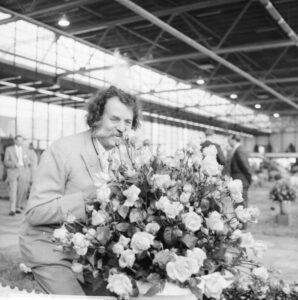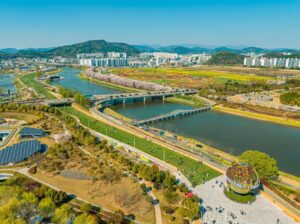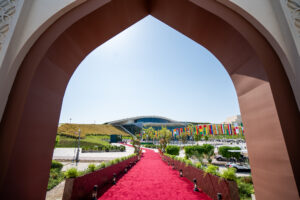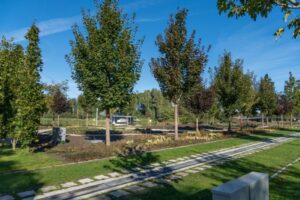
Bringing the ‘Horticultural Olympics’ Down Under!
By Gabrielle Stannus
Plans are well under way for Australia’s third Summer Olympics to be held in Brisbane in 2032. But did you know we have never held a ‘Horticultural Olympics’? According to the International Association of Horticultural Producers (AIPH), hosting such an event could provide the opportunity of a lifetime for one Australian city to recreate an urban landscape, leaving a permanent green legacy for its inhabitants.
The International Association of Horticultural Producers (AIPH) is a membership association of national horticulture industry associations which represent thousands of growers of flowers and ornamental plants around the world. AIPH’s member in Australia is Greenlife Industry Australia (GIA). AIPH’s key aim is to stimulate demand for ornamental trees, plants and flowers worldwide. One of the ways this organisation does that is through its role as the global approving body for international horticultural expos in countries across the globe.
Treve Evans, AIPH’s Senior International Relations Manager, says that the very first International Horticultural Expo was held in Rotterdam in the Netherlands. Floriade Expo 1960 was essentially a very large flower show, as were most early expos. However, the AIPH horticultural expos, whilst continuing to exhibit beautiful gardens and displays, have now evolved into showcases for innovations in environmental sustainability, climate change mitigation and urban greening and redevelopment, and offer a unique opportunity for the greenlife industry.

Expo 2022 Floriade, held in Almere near Amsterdam in the Netherlands is one example of a horticultural expo with urban redevelopment at its heart. Designed by architect Winy Maas, Floriade’s Green City Arboretum was created on top of existing natural elements such as woodland, water, an island, and a highway, arranged in an 800m x 800m grid. Landscape designer Niek Roozen implemented a bold planting scheme with an alphabetical arrangement of 3,000 trees, 90,000 shrubs, and 200,000 perennials, which remain as part of the legacy of this event1. These plantings contribute to the urban district called ‘Hortus,’ which is expected to accommodate the projected population increase from 215,000 to 300,000 in the next decade1.
All participants at Expo 2022 Floriade were asked to consider the re-use of materials after the Expo period, with most pavilions getting a new destination after the Expo, or their materials slated for reuse. Japan’s Ministry of Agriculture donated the award-winning Satoyama Farm Garden pavilion to the Oosterwold urban farming cooperative in Almere, Netherlands2. This 300m² structure was dismantled from the Expo site and is planned to be reassembled at a prominent location within Oosterwold. In its new setting, the pavilion will serve multiple purposes, including acting as a fresh produce distribution hub, knowledge centre, community space, and potentially a shop for the cooperative.
According to Treve, most horticultural expo hosts retain their event sites as public parks, gardens or event venues for recreational use and future events, saying “We have just come back from Thailand where we visited the site where the Expo 2006 Royal Flora Ratchaphruek was held in Chiang Mai. Even 20 years later, this is a beautiful park and a very big tourist destination. The park continues to maintain its international gardens, multicultural research programs and environmental conservation projects. It is now a member of the Botanic Gardens Conservation International and holds Level 3 ArbNet Accreditation, a prestigious recognition that only 49 botanic gardens worldwide have achieved. So, it has created something that people are still visiting nearly 20 years on.
“Another example is Suncheon, a very industrial city in South Korea. This city hosted the Suncheon Bay Garden Expo in 2013 because they wanted to soften the city and make it greener. This expo attracted over four million visitors. More recently, Suncheon held the Suncheonman International Garden Expo in 2023, which attracted almost 10 million visitors. Overall, visitation to the city has increased fourfold since the ‘Noughties’. Now, well over seven million visitors a year come to Suncheon.”

Another impressive horticultural expo legacy has been left in a place not usually celebrated for its greenery. The Main Building at Expo 2023 in Doha, Qatar was recognized by Guinness World Records as having the ‘Largest Green Roof’ in the world, measuring 4,031m² 3. This building has been gifted to Qatar Museums.
These large-scale events also encourage investment in new infrastructure, which becomes a permanent addition to the city and improves residents’ quality of life. For example, the 2018 World Flora Expo in Chinese Taipei saved 2,486 tons of CO2 emissions by investing in electric buses, which were kept and used regularly after that expo4.
Could Australia host an expo?
Treve says that Australia has yet to host a horticultural expo, something he put to Greenlife Industry Australia CEO, Joanna Cave during an AIPH International Congress in Poland last year. Jo hosted a forum during the recent national Greenlife Industry Conference in Brisbane to test the receptivity of the industry to holding such an event in Australia.
Jo says “I called the session the Horticultural Olympics because International Horticultural Expos involve the same type of scale and ambition of those events but without the sports. The legacy element I would judge to be even more meaningful than what happens after an Olympics. Because they have come to be, depending on which city or country hosts them, a means of completely regenerating cities or spaces, addressing the challenges presented by climate change, and designing infrastructure led entirely by green life. So, it is a very green-led project that exists permanently afterwards with infrastructure legacies such as roads and bridges, and community buildings and art galleries, as well as all the regenerated green spaces.

“The International Horticultural Expos are the only events of these kind that are entirely led first and foremost by the greenlife industry, and I use that expression in the broadest term. It is absolutely every element of industry in green life. So, the growers of the plants, the designers of the spaces, the builders of the displays, and all the others that lead that exposition. That is one thing that is quite remarkable. But the other thing is they are so ambitious. They are not just garden shows. They are not even just big garden shows. They recreate urban landscapes and leave these permanent legacies. The public six-month show is just one tiny part of the whole experience.
“The average value of an expo on the local host economy is 719 million Euros, that is around $1.2 billion. It is an exciting idea to think about. We would absolutely love to see an event like that happen here in Australia. It would be wonderful for the sector, in the very broadest sense, the world, and it would keep greenlife businesses busy for a very long time. I just love the idea of a project that the industry would lead, and it would be everyone in it. No one would be left behind in a project like this. If you are in greenlife, you could have a role.”
“Expos attract millions of visitors from across the host country, and from around the world. Garden tourism is growing exponentially,” Treve adds, “However, these expos can also be used for platforms for arts and culture, with conferences, theatre and other similar events held simultaneously. Expos are a wonderful opportunity to attract the world and invite countries to come and plant and build their gardens and pavilions. They are great occasions for cultural exchange and diplomatic relations.”
What is involved?
If a country or city wishes to host an AIPH-approved horticultural expo, they must ensure that they have the involvement and support of an AIPH member association. In Australia, that would be GIA. The next step is to decide at which level they wish to hold that event. What I have referred to interchangeably as horticultural expos thus far can be broken down into three categories of different scale: International Horticultural Expos (Category A1), International Green Expos (Category B), and International Horticultural Shows (Category C), which are shorter duration events, lasting only up to 30 days.

An ‘A1’ International Horticultural Expo is essentially the top tier event. An application to host this type of expo must demonstrate that it has received central government support, i.e. a letter from the Prime Minister, and once approved by AIPH, then recognition from the International Exhibitions Bureau (BIE), the intergovernmental organisation responsible for overseeing and regulating not only Horticultural Expos, but also World Expos and Specialised Expos. The BIE was founded in 1928 through the Paris Convention to ensure that Expos serve an educational purpose and promote international cooperation and innovation. In addition, the proposed A1 event site must be a minimum of 50ha, although they can be larger, such as the 500ha site that hosted the 2019 Expo in Beijing, China.
A ‘B’ level International Green Expo application does not require BIE recognition but must show that it has the support of the mayor or the governor of that city or state. The event site should be a minimum of 25ha. Both exhibition types require at least ten international participants and can last between three and six months.
As well as completing the necessary paperwork and ticking the right boxes, Treve says that there is one more thing that a city needs if it wants to host a horticultural expo, ambition! “This is not for the faint hearted! Most cities will not have done anything on this scale before. It really needs to have the full backing of the city leader, the city community, the business community and industry behind it to really get all the stakeholders involved to really drive it forward.”

On your marks, get set, go!
If you want to better understand the horticultural expo experience, why not visit one yourself? The next AIPH-approved A1 International Horticultural Exhibition will be held in Yokohama, Japan in 2027. I have been hankering to visit Japan for a very long time to view its horticultural delights (and to visit a brother residing in Tokyo). This just gives me one more reason to book my ticket. Treve says that the organisers of this expo are expecting 15 million visitors! If you, like many Australians, regularly visit Thailand, then consider adding A1 Expo 2029 Korat in Nakhon Ratchasima (around 300 km northeast of Bangkok) to your travel itinerary in 2029. And who knows, maybe we might just get to add an Australian leg to that horticultural tour in six to ten years’ time? Anyone for a horticultural expo? Let’s go!
Gabrielle Stannus
Inwardout Studio
M: 0400 431 277
E: gabrielle@inwardoutstudio.com
References
- AIPH. (2023, September). Blooming economies & cities to inspire the world (2nd Edition). Retrieved March 12, 2025 from https://aiph.org/wp-content/uploads/2023/09/Blooming-eco_-2th-edition.pdf
- van der Ploeg, R. (2023, January 1). A Dutch Japanese friendship built to last. FloraCulture International. Retrieved March 11, 2025, from https://aiph.org/floraculture/news/a-dutch-japanese-friendship-built-to-last/
- AIPH. (2023, October 5). Expo 2023 Doha Qatar opens in the desert to inspire visitors towards a greener future. Floral Daily. Retrieved March 12, 2025 from https://www.floraldaily.com/article/9565745/expo-2023-doha-qatar-opens-in-the-desert-to-inspire-visitors-towards-a-greener-future/
- AIPH. (n.d.). Blooming economies & cities to inspire the world. Retrieved March 12, 2025, from https://aiph.org/wp-content/uploads/2021/05/New_Blooming-Economies-and-cities_AIPH-Expo-Impacts.pdf
